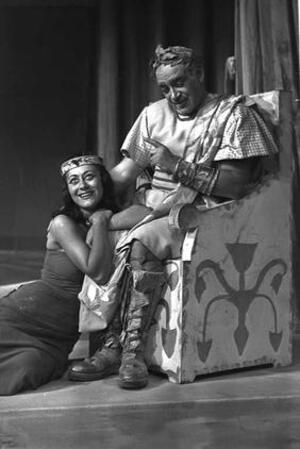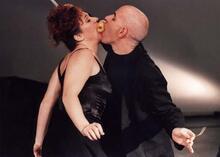Miriam Zohar
Miriam Zohar was a phenomenal dramatic actress who earned an Israel Prize for her noteworthy achievements on the stage. Born in Czernowitz in 1931, Zohar was deported by the Romanian Fascist government to a labor camp in Transnistria, a region in western Ukraine. In 1948, she began her immigration journey to Palestine illegally and was captured by the British and transferred to Cyprus, before finally arriving in Israel in 1949. Zohar was invited to perform with the theater of Ya’akov Mansdorf before becoming a Habimah member in 1951. At the Habimah she became a leading young actor, shining with highly intuitive and emotional acting. Zohar played major female roles during the 1950s, performing until 1994. In 1961 she married Arie Gelblum and they had two daughters.
In 1986 Miriam Zohar was awarded the Israel Prize for her noteworthy achievements as an outstanding actor. The prize committee based its choice on Zohar’s excellent performance in dozens of plays, both classical and modern. The varied gallery of roles she embodied was a dramatic expression of her personality, combined with professional skills and deep involvement and identification in portraying each and every character.
Early Life
Zohar was born in October 1931 as Miriam Katz, the daughter of a traditional Jewish tradesman from Czernowitz (Chernivtsi), Hanoch Katz (d. 1945), and Rachel Katz (d. 1982). She had two older brothers, Abraham (1921–2003) and Yitzhak (b. 1917). Her peaceful childhood was cruelly ruptured by the German invasion of the city. In 1941 Miriam, Yitzhak and her parents were deported by the Romanian Fascist government to Transnistria (a region in the western Ukraine), where she was forced into hard labor. When Soviet troops liberated the region in 1944, the family returned to Czernowitz. Shortly afterwards, her father was imprisoned and deported by the Soviets. In 1946 Miriam, Yitzhak, and their mother moved to Timisoara in Transylvania, and from there, in 1948, began the journey to Palestine. The family sailed on the Pan York, organized by the illegal immigration movement. The ship was captured by the British and its passengers were transferred to the camps in Cyprus. Miriam remained there for a year, during which she entered into a short-lived marriage. Only in 1949, after the establishment of the state, did she finally arrive in Israel.
Theater Career
Zohar’s encounter with the theater during those troubled years was almost accidental. She had never had the opportunity to see theater or dream of an acting career. Shortly after the war she participated in a production staged by an amateur group. She had a tiny role, in which she crossed the stage with a dog. While watching the performance again and again from backstage, she got the feeling she could play the main role as well as the leading actress. From that point on, she was attracted to the theater. In Cyprus she joined an amateur Yiddish theater group. Shortly after arriving in Israel she was invited to perform with the theater of Ya’akov Mansdorf, though she hardly spoke Hebrew. While performing the leading role in Carlo Goldoni’s Mirandolina she was seen by Shimon Finkel (1905–1999) and Zevi Friedland (1898–1967), two influential Habimah members, who were impressed with her acting. They encouraged her to audition for Habimah, which she did successfully, joining the theater in 1951. In accord with theater policy, she changed her name to Zohar (splendor), a name that seemed appropriate for a Hebrew actress.
At Habimah she rapidly became one of the leading young actors, playing some of the theater’s major female roles during the 1950s, among them Gretchen in Goethe’s Faust (1956), Solveig in Ibsen’s Peer Gynt (1951), and the title role in Aharon Megged’s Hanna Szenes (1958). However, her big breakthrough came while playing the title role in Eugene O’Neill’s Anna Christie (1957), under the direction of the American-Jewish director Hy Kalus.
Kalus was a demanding director who led his actors into developing a deep psychological identification with the characters they portrayed, thus exposing their complexity in a bare, realistic, and extremely emotional manner. Zohar, who lacked formal theater education, did not adopt any specific acting method. Her approach towards acting, which was highly intuitive and emotional, was well suited to the kind of performance at which Kalus aimed. For his part, he helped her develop her acting range and to crystallize her highly sensitive artistic ability. Kalus was also responsible for one of Zohar’s greatest achievements as an actress, directing her as Martha in Edward Albee’s Who’s Afraid of Virginia Woolf? (1965). In this role, Zohar reached the peaks of virtuosity, shifting quickly between the contradictory emotional phases Martha experiences. The role positioned her as one of the leading ladies of Israeli theater. She played it again in a revival of the production in 1976 and once more at Beit Lessin in 1988
Career Successes and Family Life
In real life Zohar was entirely different from the stormy Martha. In 1961 she married journalist and advertiser Arie Gelblum (1921–1992) and they had two daughters, Tami (b. 1963) and Nili (b. 1965). She enjoyed a stable and happy family life until Gelblum’s death in 1992, constantly declaring that her family was of a higher priority than her career. She played at Habimah uninterruptedly until 1994. Among her outstanding roles were Serafina in Tennessee Williams’s The Rose Tattoo (1971); the title role in Euripides’s Medea (1981); the title role in Schiller’s Mary Stuart (1981); and from time to time the title role and the role of Mahlah in Jacob Gordin’s Mirele Efros (1987). She was awarded the Aharon Ashman prize for her performance as a fragile Holocaust survivor in the monodrama The Journey by Maria Földes (1980).
During her long career she appeared only rarely in original Israeli plays. However, in 1990 she played the title role in Motti Lerner’s Else, which portrayed the last years of the poet Else Lasker-Schueller in Jerusalem. In 1994 she left Habimah and then worked mostly at Beit Lessin. There she began a fruitful and long-lasting collaboration with the Israeli dramatist and director Shemuel Hasfari, appearing in all parts of his autobiographical trilogy. The first part, Lit. "sanctification." Prayer recited over a cup of wine at the onset of the Sabbath or Festival.Kiddush, originally produced in 1985, was revived in 1995, with Zohar as Pnina Shiloni. In the same year she also played Elisheva in the second part, Hamez (Leavened Bread). A year later she played the role of Devorah Gorni in the last part of the trilogy, Shivah (seven days of mourning). All three characters were elderly middle-class women, Holocaust survivors who try to cling to and control their collapsing families. These roles were well suited to Zohar’s tendency to realistic acting and reflected her own public image as a Holocaust survivor who had built a stable bourgeois home in Israel.
Yefe-Nof, Yehoshua. Artists in Israel (Hebrew). Tel Aviv: 1959.
Ben-Meir, Dov, ed. Who and What in Tel Aviv-Jaffa (Hebrew). Tel Aviv: 1991.
The Israeli Documentation Center for the Performing Arts, File no. 14.1.2.





